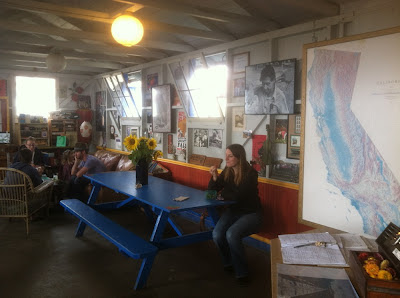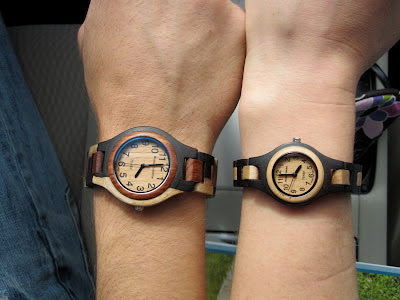We took the Pacific Coast Highway down, which has some incredible views. Google Maps told us the drive would be under 5 hours but it didn't take into account how curvy and narrow the roads were and thus how slow people go on them - it took us almost 8 hours to get there. We took some episodes of This American Life for entertainment. It was daylight for all of the trip, so we got to enjoy to enjoy some nice views of the coast. Here's a picture Greg snapped of me standing in front of Big Sur. Mom, I think this is the location Grandma painted in her California coast painting hanging downstairs.
One great thing about the PCH is that there are so many farm stands along the side of the road, and the produce they sell is fresh and picked on the farm the stand is in front of. We stopped in a little store on the side of the road that advertised fresh-picked strawberries.
It was a very fun store - the had jam sampling, board games, unbelievable homemade deserts, and they didn't have a cash register. They had the money drawer of a cash register right on the counter where you insert your cash and collect the change yourself. There was a guy standing behind the counter, but the place had the laid back feeling typical of the PCH.
Greg indulged in some of the deserts and I had a delicious basket of strawberries.
There was an adorable little shop next to this place that was inside of a trailer. We bought a jar of lavender infused honey from them.
We stayed in Cambria, which is a few miles outside of Hearst Castle. I fell in love with the town. We didn't have too much time to explore that night since we got in so late, but we did have an amazing meal at a local restaurant. Since the town is surrounded by so much farmland, all of their produce is local, in season, and fresh. There are also a few cattle ranches nearby, and I mean vast California hills with tons of grass where the cattle can roam and eat and be happy all day. We passed a few on the way down, one of which was on the Hearst estate. Most of the beef in that town comes from these ranches, and since the cattle are so healthy the beef is too (and thus tastes better).
The stores in that town were all gems. This is a town that treasures art. There were art galleries, glass shops, quilting shops, sewing shops, and, the tour de force, a knitting shop. Greg and I got out early, so we scoped out the town before any of the shops were open to see what it had. I was acting like a complete tourist, shamelessly taking pictures of everything.
You can't even imagine how excited I got when I saw the knitting shop.
After the Hearst tour we checked out some of the stores. They all had very unique and beautiful pieces.
Greg bought us some wooden watches at one store. We've never seen watches like these and they felt too California to not buy.
We went to the knitting shop last and every minute we were in there, I was in heaven. They had beautiful hand-dyed, high quality yarns, a whole wall dedicated to knitting patterns, and a very helpful staff who loved knitting and crocheting. Needless to say I spent a lot of money on yarn there, and it was worth every penny. I wish we could have spent more time in the town, but we had a long drive ahead of us. We'll just have to stay longer next time.
In contrast to the quaint hometown feeling Cambria had, Hearst Castle had a very powerful and intimidating presence. We did a 1-hour tour at Hearst castle that morning, and like I said, 1 hour is not enough. I've never seen anything that big, with that much personality, that belonged to one person. It was a 28 year project to build the entire estate, and W. R. Hearst paid attention to every last detail of it. In a time where minimal, modern houses were going up, Hearst wanted his estate to have a very classical and busy feel. There is a very strong European influence in it, but he didn't stick with one country - he wanted them all.
This was at the entrance. The gate was made out of gold.
The ceilings in every room had art on them, this was the ceiling in their cocktail room. They didn't allow flash photography inside the castle so the pictures are a bit blurry.
The fireplace, along with some paintings. There were more paintings like that all around the room.
These were from the dining room. Notice the giant tapestries he had hanging on the walls.
Surprisingly, when he entertained guests, he set the table with paper napkins instead of cloth, glass instead of crystal, and flatwear instead of silver.
This ceiling came from Spain and was created in the 15th century.
Here's another view of the castle from the outside. Since it (and its many guest houses) were on the top of a giant hill, it had some incredible views all the way down to the ocean.
There were statues all around the property
He had 2 pools, one indoor and one outdoor. This was the outdoor one, the Neptune Pool. It had a strong Greek/mediterranean influence. Notice the Greek symbols on the bottom of the pool.
This stood at the head of the pool, and must have been inspired by the Acropolis.
I dug through my old photos from when Greg and I went to Greece and found this photo from the Acropolis in Athens, so you can see the similarities.
Charlie Chaplin played tennis on this tennis court.
The last thing we saw on the tour before departing back to the visitor center (at the bottom on the hill) was the indoor pool, the Roman Pool.
That was gold on the ground we were walking on.
I find it quite amazing that one person created such an estate. W. R. Hearst was an avid collector, and his statues, or pieces of art that he fancied, were found all throughout it. For such a large residence, there was not one part of it that went undecorated. He built the castle at the end of his life, and it's as though he wasn't building it for himself, but for everyone else, so that his power and influence (keep in mind, he was the definition of media mogul) would be remembered.
































